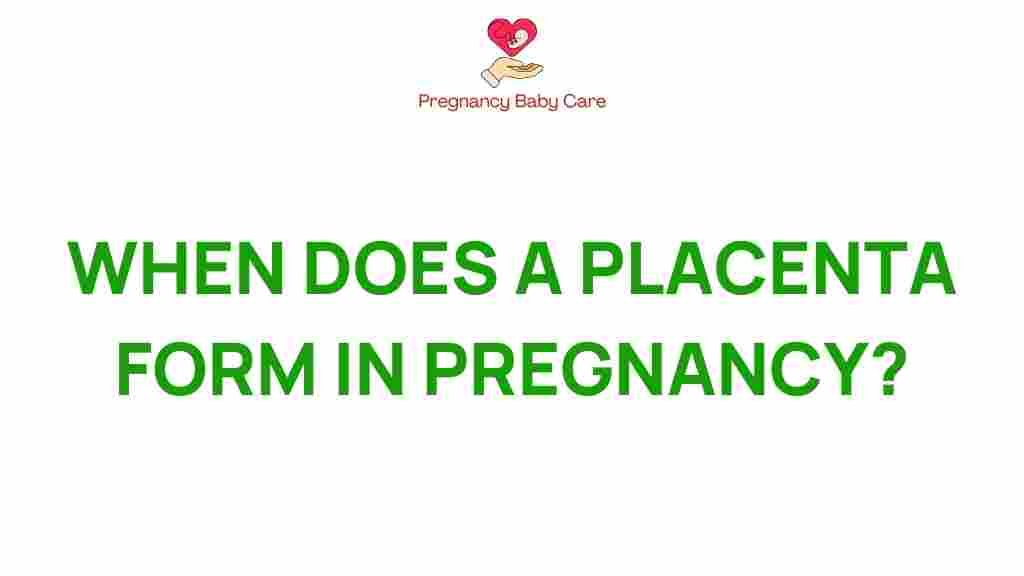Unraveling the Mystery: When Does a Placenta Form in Pregnancy?
The placenta is a remarkable organ that plays a crucial role in pregnancy, serving as the lifeline between the mother and the developing fetus. Understanding when and how the placenta forms is essential for anyone interested in fetal development, maternal health, and prenatal care. In this article, we will explore the intricate process of placenta formation, its significance during gestation, and what expectant mothers should know to ensure a healthy pregnancy.
What is the Placenta?
The placenta is a temporary organ that develops in the uterus during pregnancy. It is responsible for nutrient and oxygen exchange between the mother and the fetus, as well as the removal of waste products from the fetal blood. The placenta also produces hormones that are vital for maintaining pregnancy.
The Role of the Placenta in Fetal Development
During pregnancy, the placenta serves several key functions:
- Nutrient Transfer: The placenta allows essential nutrients such as glucose, amino acids, and fatty acids to pass from the mother to the fetus.
- Gas Exchange: Oxygen from the maternal blood is exchanged for carbon dioxide from the fetal blood.
- Hormonal Support: The placenta secretes hormones like progesterone and estrogen, which are crucial for maintaining pregnancy.
- Immune Protection: It provides a barrier that helps protect the fetus from infections while allowing some antibodies to pass through.
When Does the Placenta Form in Pregnancy?
The formation of the placenta begins shortly after conception and continues to develop throughout the first trimester and into the second trimester. Here’s a step-by-step breakdown of the placenta’s formation:
1. Fertilization and Early Development
Fertilization occurs when a sperm cell successfully penetrates an egg cell. This event marks the beginning of embryonic development. Within a few days, the fertilized egg (now called a zygote) travels down the fallopian tube toward the uterus.
2. Implantation
About 6 to 10 days after fertilization, the zygote implants itself into the uterine lining. This is a critical moment for the establishment of the pregnancy. During implantation, the cells of the developing embryo begin to interact with the maternal tissue, signaling the formation of the placenta.
3. Placental Development Begins
Once implantation occurs, the outer layer of the embryo, known as the trophoblast, starts to invade the uterine lining. This process leads to the formation of the placenta. By the end of the first trimester, the placenta is well-developed, functioning effectively to support the growing fetus.
4. Growth and Maturation
The placenta continues to grow and mature throughout the second trimester. By week 20 of pregnancy, it will have reached its full size and will weigh about 1 pound. The placenta’s vascular network becomes more complex, improving its efficiency in nutrient and gas exchange.
5. Late Pregnancy Changes
As the pregnancy progresses into the third trimester, the placenta undergoes further changes to accommodate the needs of the growing fetus. It continues to produce hormones and provide essential nutrients until delivery.
Important Trimesters for Placenta Development
Understanding the trimesters of pregnancy can help expectant mothers know when significant developments occur:
- First Trimester (Weeks 1-12): The placenta begins to form and establish its connection with the mother.
- Second Trimester (Weeks 13-26): The placenta matures and grows, enhancing its function.
- Third Trimester (Weeks 27-40): The placenta supports the fetus until delivery; monitoring its health is crucial.
Maternal Health and Prenatal Care
Maintaining maternal health is essential for proper placenta development. Here are some tips for expectant mothers:
- Regular Prenatal Check-ups: Schedule regular appointments with a healthcare provider to monitor the health of both mother and baby.
- Balanced Nutrition: Eat a well-balanced diet rich in essential nutrients to support fetal development and placental health.
- Avoid Harmful Substances: Stay away from alcohol, tobacco, and illicit drugs, as they can negatively impact placental function.
- Manage Stress: Practice stress-reduction techniques such as yoga or meditation to promote overall health.
Potential Issues with Placenta Development
While the placenta plays a vital role in pregnancy, certain complications can arise that may affect its function:
1. Placenta Previa
This condition occurs when the placenta partially or completely covers the cervix, which can lead to bleeding and complications during delivery. Regular ultrasounds can help monitor this condition.
2. Placental Abruption
This is a serious condition where the placenta detaches from the uterine wall before delivery, which can cause heavy bleeding and jeopardize both maternal and fetal health. It requires immediate medical attention.
3. Inadequate Placental Function
Sometimes, the placenta may not function effectively, leading to conditions like intrauterine growth restriction (IUGR), where the fetus does not grow as expected. This can be monitored through ultrasounds and other assessments.
4. Gestational Diabetes
Gestational diabetes can affect placental health and fetal development. It is essential for pregnant women to have their blood sugar levels monitored and managed effectively.
Conclusion
Understanding when and how the placenta forms in pregnancy is crucial for expectant mothers. This remarkable organ is vital for fetal development and maternal health throughout gestation. Regular prenatal care, a healthy lifestyle, and awareness of possible complications can help ensure a healthy pregnancy.
As a reminder, if you have any concerns about your pregnancy or placental health, please consult your healthcare provider for personalized advice and care. For more information on prenatal care, visit this resource.
For further reading on embryology and fetal development, check out this informative article.
This article is in the category Pregnancy and created by PregnancyBabyCare Team
